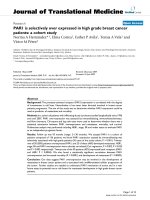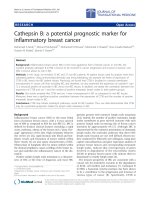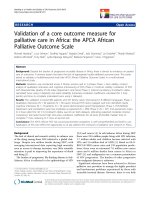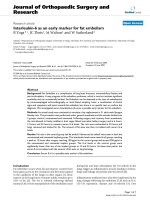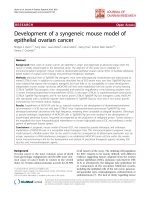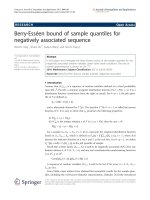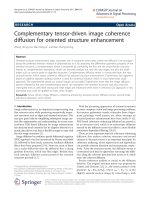Báo cáo hóa học: " Cathepsin B: a potential prognostic marker for inflammatory breast cancer" ppt
Bạn đang xem bản rút gọn của tài liệu. Xem và tải ngay bản đầy đủ của tài liệu tại đây (1.22 MB, 8 trang )
RESEARCH Open Access
Cathepsin B: a potential prognostic marker for
inflammatory breast cancer
Mohamed A Nouh
1†
, Mona M Mohamed
2*†
, Mohamed El-Shinawi
3
, Mohamed A Shaalan
4
, Dora Cavallo-Medved
5,6
,
Hussein M Khaled
7
, Bonnie F Sloane
5,8
Abstract
Background: Inflammatory breast cancer (IBC) is the most aggressive form of breast cancer. In non-IBC, the
cysteine protease cathepsin B (CTSB) is known to be involved in cancer progression and invasion; however, very
little is known about its role in IBC.
Methods: In this study, we enrolled 23 IBC and 27 non-IBC patients. All patient tissues used for analysis were from
untreated patients. Using immunohistochemistry and immunoblotting, we assessed the levels of expression of
CTSB in IBC versus non-IBC patient tissues. Previously, we found that CTSB is localized to caveolar membrane
microdomains in cancer cell lines including IBC, and therefore, we also examined the expression of caveolin-1 (cav-
1), a structural protein of caveolae in IBC versus non-IBC tissues. In addition, we tested the correlation between the
expression of CTSB and cav-1 and the number of positive metastatic lymph nodes in both patient groups.
Results: Our results revealed that CTSB and cav-1 were overexpressed in IBC as compared to non-IBC tissues.
Moreover, there was a significant positive correlation between the expression of CTSB and the number of positive
metastatic lymph nodes in IBC.
Conclusions: CTSB may initiate proteolytic pathways crucial for IBC invasion. Thus, our data demonstrate that CTSB
may be a potential prognostic marker for lymph node metast asis in IBC.
Background
Inflammatory b reast cancer (IBC) is the most lethal
form of primary breast cancer, with a 3-year survival
rate of 40% as compared to 85% for non-IBC [1]. IBC is
defined by distinct clinical features including a rapid
onset, erythema, edema of the breast and a “peau d’or-
ange” appearance of the skin. High metastatic behavior
(for review see [2]), rapid invasion into blood and lym-
phatic vessels and formation of tumor emboli within
these vessels [3] are also major characteristics of IBC.
Obstruction of lymphatic flow by tumor emboli within
the dermal lymphatics causes sw elling of the breast tis-
sue and underlies the inflammatory nature of the dis-
ease[3].
Positive axillary lymph node metastasis is a character-
istic of IBC at the time of diagnosis and most IBC
patients present with extensive lymph node metastasis
[3,4]. Indeed, the number of positive metastatic lymph
nodes contributes to poor survival outcome with each
positive lymph node increasing risk of breast cancer
mortalitybyapproximately6%[5].AlthoughIBCis
characterized by the extensive presentation of metastatic
lymph nodes, the molecular pathways that direct IBC
lymph node invasion are not well defined. Recent stu-
dies conducted by Ellsworth and colleagues, using laser
capture m icrodissection and gene expression analysis o f
primary breast tumors and corresponding metastatic
lymph nodes, indicate that overexpression of genes
involved in degradation of the extracellular matrix
(ECM) in primary breast cancer ce lls induces them to
disseminate to nearby lymph nodes [6].
The invasive properties of IBC are consistent with a
crucial role for proteolytic enzymes in the degradation
of ECM, cell motility and metastasis [7]. Cathepsin B
(CTSB), a lysosomal cysteine protease, has been shown
to be a contributor to the progression and invasion of
various types of cancer [8]. Specifically, CTSB is
* Correspondence:
† Contributed equally
2
Department of Zoology, Faculty of Science, Cairo University, Giza 12613
Egypt
Full list of author information is available at the end of the article
Nouh et al. Journal of Translational Medicine 2011, 9:1
/>© 2011 Nouh et al; licensee BioMed Central Ltd. This is an Open Access article distributed u nder the terms of the Creative Commons
Attribution Lic ense (http://creativec ommons.org/licenses/by/2.0), which permits unrestricted use, distribution, and reproductio n in
any medium, provided the original work is properly cited.
involved in proteolytic pathways that lead to the degrada-
tion of ECM proteins t hereby promoting cancer cell
motility and invasion [8,9]. In cancer cells, CTSB is
shuttled to the plasma membrane where it can activate
receptor-bound pro-urokinase-type plasminogen activa-
tor (pro-uPA). uPA activate plasminogen a serine pro-
tease that can digest ECM proteins and activate MMPs, a
family of proteolytic enzymes that are also major partici-
pants in ECM degradation and cancer cell motility and
invasion [10]. CTSB is associated with cell surface caveo-
lae, specialized membrane microdomains that are
involved in signaling pathways, endocytosis and proteoly-
sis (for review see [11,12]). The role of caveolin-1 (cav-1),
the main structural protein of caveolae, in cancer pro-
gression and invasion is contradictory and appears to
depend upon the cancer type and stage of progression. In
IBC patient tissues and cell lines, cav-1 is overexpressed
[7], a phenotype observed in other aggressive breast car-
cinomas that show high metaplastic properties [13].
Overexpression of cav-1 has been shown to be associated
with ECM degradation and formation of invadopodia,
which contain membrane-type-1-MMP (MT1-MMP)
and mediate breast cancer cell motility and invasion [14].
In previous in vitro studies, we have shown that interac-
tion of IBC cells with human monocytes augments inva-
sion of IBC cells through increased ECM degradation,
events correlated with an increase in CTSB expression,
secretion and activity and an increase in cav-1 expression
in the IBC cells [15]. More recently, we have co-localized
active CTSB and uPA with cav-1 in caveolar fractions of
SUM149 IBC cells (unpublished data).
In the present study, we assessed the expression levels
of CTSB and cav-1 in IBC versus non-IBC patient breast
tissues. Furthermore, we examined the correlation
between these proteins and the number o f metastatic
lymph nodes in IBC versus non-IBC patient tissues. Our
results revealed an overexpression of CTSB and cav-1 in
IBC tissues and demonstrated a positive correlation
between CTSB expression and t he number of positive
lymph node metastases. We speculate that CTSB
expressed by tumor ce lls and localized in c aveolae may
promote IBC metastasis to lymph nodes by enhancing
ECM degradation and tumor invasion.
Methods
Patients and Tissue Specimens
For the purpose of patient enrollment in this study, we
obtained Institutional Review Board (IRB) approval from
the ethics committee of Ain-Shams University and the
National Cancer Institute (NCI), Cairo University.
Patient s were selected from those referred to out patient
breas t clinics of Ain Shams University hospital and NCI
Cairo University during the period of June 2008 to
December 2009. Inclusio n criteria of breast cancer
patients were dependent upon a combination of clinical,
mammographic, ultrasound, and pathological diagnoses .
Clinical diagnosis of IBC is applied, according to the
American Joint Committee on Cancer (AJCC) T4 d des-
ignation for IBC (for review see [16]), when a patient
presented with a diffuse erythema, peau d’ orange and
edema of the breast (Figure 1) . For IBC patient s, patho-
logical confirmation of the clinical diagnosis was depen-
dent upon examination of both skin and co re biopsies
(M.A.N.). In the absence of breast masses, diagnosis was
depended upon pathological examination o f skin biop-
sies that showed permeation of dermal lymphatics by
carcinoma cells and the presence of dermal tumor
emboli (M.A.N.). Non-IBC patients of stage II-III were
also included in our study as a comparison group.
Patients subjected to neo-adjuvant chemotherapy or
those with viral hepatit is or autoimmu ne disease were
excluded from our study. Based on the criteria described
here, we enrolled 23 IBC and 27 non-IBC patients in the
present study.
Tissue samples were fixed in 10% neutral buffered for-
malin and processed into paraffin blocks for routine sec-
tioning and immunohistochemistry (IHC). Pathological
data regarding tumor size, tumor grade [17], and the
presence of lymphovascular invasion, dermal tumor
emboli and tumor parenchyma emboli [2,18] were
assessed(M.A.N),reviewed(H.I.)andtabulatedforsta-
tistical analysis. Add itional sections were generated from
the paraffin tissue blocks and immunostained for estro-
gen receptor (ER), progesterone receptor (PR) and
Figure 1 Photograph of IBC patient showing clinical criteria for
IBC diagnosis, i.e., edema, erythema (blue arrow) and peau
d’orange (black arrow).
Nouh et al. Journal of Translational Medicine 2011, 9:1
/>Page 2 of 8
HER2-neu expression status. IHC staining for CTSB,
and cav-1 was performed as described below.
Immunohistochemistry
Mouse anti-caveolin-1 was purchased from BD Bios-
ciences (San Diego, CA, USA) and polyclonal rabbit
anti-human CTSB antibody was previously prepared in
house (B.F.S.) [ 19]. Antibody diluent with background
reducing components and DakoCytomation EnVision+
Dual Link System-HRP (DAB+) kits were purchased
from D ako (Carpinteria, CA, USA); and Permount® was
from Fisher Scientific (Pittsburgh, PA, USA).
Tissue sections were prepared from paraffin blocks and
stained with hematoxylin and eosin to select tissue sec-
tions for immunosta ining and scoring. IHC staining for
each marker was performed in duplicate on 5 μmthick
tissue sections. Tissue sections were first deparaffinized
and rehydrated followe d by antigen retrieval. Tissue sec-
tions were incubated for 1 hour at room temperature
with the following primary antibodies prepared in Dako
Antibody diluent with reduced background components:
polyclonal CTSB antibody (1:500) and monoclonal anti-
cav-1 (1:150). Detection was carried out by incubating
tissue sections with 100 μl of horse radish peroxidase-
labeled rabbit or mouse secondary antibody [EnVision+
Dual Link System-HRP (DAB+)] for 45 min. Staining was
achieved by adding 100 μl of DAB+ diluted 1:50 in sub-
strate buffer [EnVision+ Dual Link System-HRP (DAB+)]
for 15 min. Nuclei were counterstained with hematoxylin
and specimens were rinsed in PBS and mounted using
Permount® for microscopic examination. Negative co n-
trol slides were run in parallel in which each primary
antibody was replaced with PBS.
Two independent readers (M.A.N. and M.M.M.)
assessed immunostaining of CTSB and cav-1 us ing light
microscopy (Olympus, CX41, Japan). Discord ant results
were resolved by c onsultation with a third reader (H.I.).
The expression of CTSB B and cav-1 was scored accord-
ing to both the intensity of staining and the proportion
of positive staining carcinoma c ells within the entire
slide: “0”, no immunostaining was observed within carci-
noma cells; “+”, less than 10% of carcinoma cells showed
cytoplasmic staining of moderate to marked intensity; “+
+”, 10-50% of carcinoma cells showed cytoplasmic stain-
ing of moderat e to marked i ntensity; and “+++”,greater
than 50% of carcino ma cells sho w cyto plasmic st aini ng
of moderate to marked intensity.
SDS-Polyacrylamide Gel Electrophoresis (PAGE) and
Immunoblotting
Peroxidase-labeled goat anti-rabbit secondary antibody
and tetramethy l benzidine (TMB m embrane peroxidase
substrate were purchased from Kirkegaard and Perry
Laboratories Inc (Gaithersburg, MD, USA).
Fresh breast tissue specimen obtained from core
biopsy or during modified ra dical mastectomy were
minced into small pieces on ice in RIPA buffer [25 mM
Tris-HCl pH 7.6, 150 mM NaCl, 1% NP-40, 1% sodium
deoxycholate, 0.1% SDS (Sigma-Aldrich, St. Louis, MO,
USA)]. Protein concentrations of cell lysates were mea-
sured using Bra dford reagent (Sigma-Aldrich, Germany).
Samples were equal ly loaded (20 μg protein/well), sepa-
rated by 12% SDS-PAGE under reducing conditions and
trans ferred o nto nitro cellulose membranes as previou sly
described [20]. Immunoblotting analysis was performed
using primary antibodies against CTSB (1:4000) and
caveolin-1 (1:5000) and a secondary antibody conjugated
with horseradish peroxidase (1:10,000) in Tris-buffered
saline wash buffer (20 mM Tris, pH 7.5, 0.5 M NaCl)
containing 0.5% Tween 20 and 5% (w/v) non-fat dry
milk. After washing, bo und antibodies were detected by
adding a TMB chromagen/substrate solution. Once a
signal was detected reactions were terminated by
immersing membranes in water for 20-30 seconds.
Statistical Analysis
ThedatawereanalyzedusingSPSSsoftwareversion
16.0. Differences were evaluated by Student’st-testand
Fisher’s exact test. Immunohistochemical scores of 0
and + were considered negative and scores of ++ and +
++ were considered positive. Fisher exact test was per-
formed to analyze differences in CTSB and cav-1 immu-
nostaining (i.e., positive versus ne gative) between IBC
and non-IBC groups. Cor relations b etween ca tegorical
variables were assessed using Fisher’s exact test as pre-
viously described [21].
Results
Clinical and pathological characterization of IBC versus
non-IBC patients
Clinical and pathological characterization of the IBC
(n = 23) and non-IBC patients (n = 27) used in this
study is indicated in Table 1. Age of IBC patients ranged
from 2 9-60 years (mean age of 40.9 ± 7.5), whereas the
age of non-IBC patients rang ed from 33-67 years (med-
ian age of 49.9 ± 9.1 Thus, IBC patients were signifi-
cantly (P = 0.001) younger at the time of diagnosis as
compared to non-IBC patients.
Tumor size measurements revealed that 5 IBC
patients (21.7%) presented with no tumor mass that
coul d be detected clinically, mammographically or upon
examination of the mastectomy specimen; however,
tumor emboli were present in skin and cor e biopsies.
For IBC patients with detectable masses, 5.6% of them
exhibited tumo r masses less than 2 cm and 94.4% had a
tumor mass more than 2 cm with tumor sizes ranging
from 4-10 cm (mean size of 6.5 ± 3.3 cm). Non-IBC
patients had tumor sizes ranging from 1. 8-12 cm (mean
Nouh et al. Journal of Translational Medicine 2011, 9:1
/>Page 3 of 8
size of 4.3 ± 2.3 cm) with 3.7% having tumor sizes less
than 2 cm and 96.3% having tumor sizes great er than or
equal to 2 cm.
Tumor grading revealed that 65% of IBC patients were
tumor grade I or II and 35% were tumor grade III. In
non-IBC patients 77.8% were diagnosed as tumor grade
I or II, and 22.2% were diagnosed as tumor grade III.
We assessed the number of axillary lymph nodes that
were positive for metastases in IBC versus non-IBC
patients. All IBC patients w ho underwent surgery had
positive metastatic lymp h nodes: 15% had 1-3 positive
metastatic lymph nodes, 30% had 4-7 positive metastatic
lymph nodes and 55% had greater than or equal to 8
positive metastatic lymph nodes. Among non-IBC
patients, 25.9% were node negative, 33.4% had 1-3 meta-
static lymph nodes, 22.2% had 4-7 metastatic lymph
nodes and 18.5% had greater than or equal to 8 positi ve
metastatic lymph nodes. In a ddition, the difference
between the number of positive metastatic lymph nodes
in IBC versus non-IBC patients was determined to be
statistically significant (P = 0.037).
Lymphovascular invasion was significantly greater (P =
0.000) in IBC (73.9%) versus non-IBC (11.1%) patients.
Tumor emboli, a phenotypic hallmark of IBC and
defined as tight tumor cell clusters retracted away from
the surrounding endothelial l ining [2,18], were detected
in 100% of IBC tissue sections as compared to only
11.1% of non- IBC tissue section s (P = 0.000). Positive
staining for ER, PR and HER-2 was detected in 27.3%,
31.8% and 18.2% of the IBC patients, respectively. In
non-IBC patients, positive staining for ER, PR and HER-
2 was 22.2%, 29.6% and 14.8%, respectively.
Overexpression of CTSB in IBC versus non-IBC tissues
To a ssess the level of e xpression of CTSB in tissue homoge-
nates o f IBC versus non-IBC patients, we used immunoblot-
ting analysis. Results showed that different forms of CTSB
comprising pro-CTSB (46-kDa); intermediate-CTSB (38
kDa); and mature-CTSB forms (31 kDa single chain and 25/
26 kDa double chain) were highly expressed in IBC tissues
(Figure 2A) as compared to non-IBC tissues (Figure 2B).
To further localize cellular expression of CTSB in IBC
versus non-IBC carcinoma cells, we used IHC to stain
CTSB in paraffin embedded tissue sections. Results of
IHC staining were scored for the intensity of CTSB
staining (Table 2). CTSB w as localized in the cytoplasm
and cell membrane of IBC tumor emboli (Figure 2C)
and non-IBC carcinoma cells (Figure 2D).
IHC scoring results revealed a statistical significance
( P = 0.025) in the level of expression of CTSB in IBC
versus non-IBC carcinoma cells. In IBC, 34.8% showed
CTSB staining score of ++ and 65.2% showed staining
scoreof+++.Innon-IBC,CTSBstainingwasvariable
with 3.7% scoring 0, 18.5% scoring +, 25.9% scoring ++
and 51.9% scoring +++ (Table 2).
Overexpression of cav-1 in IBC versus non-IBC tissues
Immunoblot analysi s revealed an overexpression of cav-
1 (22 kDa) in IBC tissues as compared to non-IBC tis-
sues (Figure 3A and 3B). Using IHC staining, we showed
that 100% of IBC tissues express cav-1 (Figure 3C)
whereas only 51.8% of non-IBC samples expressed cav-1
(Figure 3D). Scoring for c av-1 expression in IBC (Figure 3 C)
cells was as follows: 30.4% scored +, 39.2% scored ++ and
30.4% scored +++ (Tab le 2). In the non-IBC tissues (Fig-
ure 3D), 48.2% of patient tissue samples revealed negative
staining for cav-1 in carc inoma cells, whereas 29.6%
scored +, 7.4% scored ++ and 14.8% scored +++ (Tabl e
Table 1 Clinical and pathological characterization of IBC
versus non-IBC patients
Clinical characteristic IBC
n = 23 (%)
Non-IBC
n = 27 (%)
p-value
Age
Range 29-60 33-67 0.001
a
*
Mean ± SD 40.9 ± 7.5 49.9 ± 9.1 t- test
Tumor size‡
Mean ± SD 6.5 ± 3.3 4.31 ± 2.30 1.000
b
< 2 1 (5.6%) 1 (3.7%)
≥ 2 17 (94.4%) 26 (96.3%)
Tumor grade
I- II 15 (65%) 21 (77.8%) 0.511
b
III 8(35%) 6 (22.2%)
Axillary Lymph Node Status†
Negative 0(0%) 7 (25.9%) 0.037
b
*
< 4 3 (15%) 9 (33.4%)
4-7 6 (30%) 6 (22.2%)
≥ 8 11(55%) 5 (18.5%)
ER
Positive 6 (27.3%) 6 (22.2%)
Negative 17 (72.7%) 21 (77.8%) 0.747
b
PR
Positive 7 (31.8%) 8 (29.6%) 1.000
b
Negative 16 (68.2%) 19 (70.4%)
HER-2
Positive 4 (18.2%) 4 (14.8%) 1.000
b
Negative 19 (81.8%) 23 (85.2%)
Lymphovascular invasion
Positive 17 (73.9%) 3 (11.1%) 0.000
b
*
Negative 6 (26.1%) 24 (88.9%)
Tumor emboli
Positive 23 (100%) 3 (11.1%) 0.000
b
*
Negative 0 24 (88.9%)
* Significant p value calculated by
a
Student- T test or
b
Fisher’s exactTest.
‡ n = 18 (five IBC patients did not have a tumor mass).
† n = 20 (three patients were not evaluated because they died before
surgery).
Nouh et al. Journal of Translational Medicine 2011, 9:1
/>Page 4 of 8
2). Our results revealed a statistically significant overex-
pression of cav-1 (P = 0.001) in IBC versus non-IBC
patients. The present results agree with those of Van den
Eynden et al. [7] in demonstrating an o verexpression of
cav-1 in IBC patient tissues.
Expression of CTSB correlates with positive metastatic
lymph nodes in IBC
We tested whether the number of positive metastatic
lymph nodes correlates with the expression levels of
each of CTSB and cav-1 in IBC versus non-IBC
patient tissues. In the IBC patient group, CTSB
showed a statistically significant correlation (P =
0.0478) with the p resence of positive metastatic lymph
nodes a s compared to t he non-IBC group (Table 3).
Cav-1 expression showed statistically non-significant
correlation (P = 0.0717-this number does not match
table 3) with the number of positive lymph node
metastasis (Tab le 3).
Thus, our data reveal that the overexpression of CTSB
in IBC versus non-IBC is significantly correlated with
the increase in number of positive metastatic lymph
nodes, suggesting a potential role for this proteolytic
enzyme in promoting the invasion of IBC cells into lym-
phatic vessels.
Discussion
Criteria for the TNM staging system for breast cancer
indicate that the number of positive metastatic axillary
lymph nodes is one of the most important prognostic fac-
tors for predicting a low survival rate of breast cancer
patients [22]. Despite therapeutic regimes, patients with
10 or more positive lymph nodes have a 70% chance of
disease recurrence [23,24]. Indeed, dissemination of IBC
cells to lymph nodes is consistent with the aggressive
phenotype of IBC although the molecular and cellular
pathways underlining this process are poorly understood.
In the present study, we show a significant positive corre-
lation between expression of the cysteine protease CSTB
and the number of metastat ic lymph nodes in IBC
patients. In addition, cav- 1 was also shown to be overex-
pressed in IBC tissue as compared to non-IBC tissue.
Figure 2 CTSB expression in IBC versus non-IBC tissues. [A] Expression of CTSB in IBC tissue homogenates from 7 different patients (lanes 1-7)
was determined by immunoblotting. The forms of CTSB detected were the proenzyme (46 kDa), an intermediate form (38 kDa), single chain
mature enzyme (31 kDa) and the heavy chain of double chain mature enzyme (25/26 kDa). b-actin was used as a loading control. [B] Tumor
lymphatic emboli in IBC tissue sections, showing CTSB immunostaining (magnification X400). [C] Expression of CTSB in non-IBC tissue homogenates
from 7 different patients (lanes 1-7) by immunoblotting analysis. [D] Immunostaining for CTSB in non-IBC tissue (magnification X400).
Table 2 Scoring of CTSB and cav-1 expression in breast
carcinoma cells in IBC versus non-IBC tissues
CTSB Cav-1
IBC Non-IBC IBC Non-IBC
n (%) n (%) n (%) n (%)
negative 0 (0%) 1 (3.7%) 0 (0%) 13 (48.2%)
+ 0(0%) 5 (18.5%) 7 (30.4%) 8 (29.6%)
++ 8 (34.8%) 7 (25.9%) 9 (39.2%) 2 (7.4%)
+++ 15 (65.2%) 14 (51.9%) 7 (30.4%) 4 (14.8%)
Fisher’s exact test P = 0.025* P = 0.001*
n: number of patients.
* Significant P value.
Nouh et al. Journal of Translational Medicine 2011, 9:1
/>Page 5 of 8
Our previous in vitro s tudies s howed that in creased
ECM degradation and i nvasion of the SUM149 IBC cell
line are associated with an overexpression of CTSB and
cav-1 [15]. Cav-1 is the main s tructural protein of lipid
raft ca veolae, a site that has been hypothesized to loca-
lize cell surface proteases involved in pericellular proteo-
lytic events [12]. Indeed, downregulation of cav-1 in
colore ctal carcinoma cells decreased trafficking of CTSB
to caveolae on the surface of these cells and decreased
degradation of ECM proteins and cellular invasion [25].
Although the role of cav-1 in breast cancer is contradic-
tory, overexp ression of cav-1 is present in aggressive
types of breast cancer such as metaplastic carcinoma
[13] and IBC [7]. Moreover, in IBC cell lines and tissues,
overexpression of cav-1 i s correlated with increased
RhoC expression, a GTPase involved in cell motility and
invasion [7]. In the present study, overexpression of cav-1
did not significantly correlate with an increase in
expression of CSTB; however, current studies in our
laboratory have localized CTSB to caveolae of SUM149
IBC cells (unpublished data). Moreover these cells exhi-
bit extracellular degradation o f ECM proteins that was
partially blocked by cysteine and serine protease inhibi-
tors (unpublished data). Thus, our data suggest that
overexpr ession of cav-1 in IBC cells contribut es to pro -
teolytic ev ents involvi ng CTS B that lead to ECM degra-
dation, tumor invasion and metastasis.
IBC is characterized by extensive involvement of positive
metastatic lymph nodes, which are associated with the
aggressive phenotyp e of the disease [26] and are a deter-
mining factor in therapeutic decisions [27-29]. As such,
we determined whether there were correlations between
CTSB and cav-1 and the number of positive metastatic
lymph nodes in IBC versus non-IBC patients. Our results
revealed a statistically significant positive correlation only
between the level of CTSB expression in IBC carcinoma
cells and the number of positive metastati c lymph nodes
(P = 0.0478). Such a correlation was not detected in non-
IBC patients. A positive correlation between CTSB expres-
sion and the metastasis of carcinoma cells to lymph nodes
has previously been reported in breast [30], prostate [31]
and gastric [32] cancers. Overexpression of CTSB in breast
cancer has been shown to enhance tumor growth and
invasion [33]. This parallels increased recurrence and
shortened disease-free survival [30] . Moreover in an ani-
mal mammary cancer model, the number of positive
metastatic lymph nodes has also been found to be
Figure 3 Cav-1 expression in IBC versus non-IBC tissues. [A] Immunoblot analysis showing expression of cav-1 (22 kDa) in IBC tissue
homogenates from 7 different patients (lanes 1-7). [B] Tumor lymphatic emboli in IBC tissue sections showing expression of cav-1 (magnification
X400) [C] Cav-1 level of expression in non-IBC tissue homogenates from 7 different patients (lanes 1-7). [D] Non-IBC invasive ductal carcinoma
showing expression of cav-1 in breast carcinoma cells (magnification X200).
Table 3 Correlation between lymph node metastasis and
expression of CTSB and cav-1 in IBC versus non-IBC
patients
Variable CTSB Expression Cav-1 Expression
IBC (%) Non-IBC
(%)
IBC (%) Non-IBC
(%)
Lymph node
metastasis
Negative 0 (0%) 5 (23.8%) 0 (0%) 3 (27.2%)
Positive 20
(100%)
16 (76.25) 14
(100%)
8 (72.7%)
Fisher’s exact test P = 0.0478* P = 0.0717
*Significant p value calculated by Fisher’s exact test.
Nouh et al. Journal of Translational Medicine 2011, 9:1
/>Page 6 of 8
associated with expression of CTSB [34]. Thus, our data
are consistent with a crucial role for CTSB in promoting
the highly metastatic behaviour of IBC.
Conclusions
The positive co rrelation between CTSB and nodal meta-
static burden in IBC patients suggests that this proteoly-
tic e nzyme may promote nodal metastasis in IBC
patients. We hypothesize that the overexpression of cav-
1 in IBC increases trafficking of CTSB to the cell surface
where it promotes IBC invasion into lymphatic vessels
and m etastasis to lymph nodes. Further studies to vali-
date CTSB as a pr ognostic marker in IBC and delineate
the mechanisms by which the association of CTSB with
cav-1 is involved in lymph node metastasis in IBC
patients are in progress.
Acknowledgements
We acknowledge the contribution of Prof. Hoda Ismail (Department of
Pathology, National Cancer Institute, Cairo University, Giza, Egypt) for her
assistance in reviewing and scoring of pathology slides. We also thank Ms. A
Dhiaa Alraawi and Ms. Marwa Tantawy (Department of Zoology, Cairo
University, Giza, Egypt) for their assistance in the statistical analysis and
immunoblotting, respectively. The authors were supporte d by Avon Grant #
02-2007-049 (M.M.M., B.F.S.) and Science and Technology Development
Funds (Grant # 343 and 408), Egypt (M.M.M.).
Author details
1
Department of Pathology, National Cancer Institute, Cairo University, Giza
12613 Egypt.
2
Department of Zoology, Faculty of Science, Cairo University,
Giza 12613 Egypt.
3
Department of General Surgery, Faculty of Medicine, Ain
Shams University, Cairo 11566, Egypt.
4
Department of Surgery, National
Cancer institute, Cairo University, Giza 12613 Egypt.
5
Department of
Pharmacology, Wayne State University, Detroit, MI 48201, USA.
6
Department
of Biological Sciences, University of Windsor, Windsor, ON, N9B 3P4 Canada.
7
Department of Medical Oncology, National Cancer Institute, Cairo University,
Giza 12613 Egypt.
8
Barbara Ann Karmanos Cancer Institute, Wayne State
University, Detroit, MI 48201, USA.
Authors’ contributions
All authors read and approved the final manuscript
B.F.S., M.M.M. and D.C.M. were responsible for the design of the study and
critical revisions of the manuscript. M.A.N. was responsible for patients’
pathological evaluation, performing IHC and scoring analysis. M.M.M. was
responsible for conducting laboratory experimental procedures, their
interpretation and manuscript preparation. M.E.S. was responsible for
patients’ recruitment, clinical diagnosis, patients’ follow-up, providing
patients’ data and contributions to manuscript preparation. M.A.S.
participated in patients’ recruitment. H.M.K was responsible for patients ’
treatment decisions, participated in scientific discussions and revision of the
manuscript.
Competing interests
The authors declare that they have no competing interests.
Received: 21 August 2010 Accepted: 3 January 2011
Published: 3 January 2011
References
1. Lerebours F, Bieche I, Lidereau R: Update on inflammatory breast cancer.
Breast Cancer Res 2005, 7:52-58.
2. Gong Y: Pathologic aspects of inflammatory breast cancer: part 2. Biologic
insights into its aggressive phenotype. Semin Oncol 2008, 35:33-40.
3. Van Laere SJ, Van den Eynden GG, Van der Auwera I, Vandenberghe M, van
Dam P, Van Marck EA, van Golen KL, Vermeulen PB, Dirix LY: Identification
of cell-of-origin breast tumor subtypes in inflammatory breast cancer by
gene expression profiling. Breast Cancer Res Treat 2006, 95:243-255.
4. Alberini JL, Lerebours F, Wartski M, Fourme E, Le Stanc E, Gontier E,
Madar O, Cherel P, Pecking AP: 18F-fluorodeoxyglucose positron emission
tomography/computed tomography (FDG-PET/CT) imaging in the
staging and prognosis of inflammatory breast cancer. Cancer 2009,
115:5038-5047.
5. Michaelson JS, Chen LL, Silverstein MJ, Cheongsiatmoy JA, Mihm MC Jr,
Sober AJ, Tanabe KK, Smith BL, Younger J: Why cancer at the primary site
and in the lymph nodes contributes to the risk of cancer death. Cancer
2009, 115:5084-5094.
6. Ellsworth RE, Seebach J, Field LA, Heckman C, Kane J, Hooke JA, Love B,
Shriver CD: A gene expression signature that defines breast cancer
metastases. Clin Exp Metastasis 2009, 26:205-213.
7. Van den Eynden GG, Van Laere SJ, Van der Auwera I, Merajver SD, Van
Marck EA, van Dam P, Vermeulen PB, Dirix LY, van Golen KL:
Overexpression of caveolin-1 and -2 in cell lines and in human samples
of inflammatory breast cancer. Breast Cancer Res Treat 2006, 95:219-228.
8. Mohamed MM, Sloane BF: Cysteine cathepsins: multifunctional enzymes
in cancer. Nat Rev Cancer 2006, 6:764-775.
9. Ren WP, Sloane BF: Cathepsins D and B in breast cancer. Cancer Treat Res
1996, 83:325-352.
10. Kobayashi H, Moniwa N, Sugimura M, Shinohara H, Ohi H, Terao T: Effects
of membrane-associated cathepsin B on the activation of receptor-
bound prourokinase and subsequent invasion of reconstituted
basement membranes. Biochim Biophys Acta 1993, 1178:55-62.
11. Anderson RG: The caveolae membrane system. Annu Rev Biochem 1998,
67:199-225.
12. Cavallo-Medved D, Sloane BF: Cell-surface cathepsin B: understanding its
functional significance. Curr Top Dev Biol 2003, 54:313-341.
13. Elsheikh SE, Green AR, Rakha EA, Samaka RM, Ammar AA, Powe D, Reis-
Filho JS, Ellis IO: Caveolin 1 and Caveolin 2 are associated with breast
cancer basal-like and triple-negative immunophenotype. Br J Cancer
2008, 99:327-334.
14. Yamaguchi H, Takeo Y, Yoshida S, Kouchi Z, Nakamura Y, Fukami K: Lipid
rafts and caveolin-1 are required for invadopodia formation and
extracellular matrix degradation by human breast cancer cells. Cancer
Res 2009, 69:8594-8602.
15.
Mohamed MM, Cavallo-Medved D, Sloane BF: Human monocytes augment
invasiveness and proteolytic activity of inflammatory breast cancer. Biol
Chem 2008, 389:1117-1121.
16. Dawood S, Merajver SD, Viens P, Vermeulen PB, Swain SM, Buchholz TA,
Dirix LY, Levine PH, Lucci A, Krishnamurthy S, Robertson FM,
Woodward WA, Yang WT, Ueno NT, Cristofanilli M: International expert
panel on inflammatory breast cancer: consensus statement for
standardized diagnosis and treatment. Ann Oncol 2010.
17. Genestie C, Zafrani B, Asselain B, Fourquet A, Rozan S, Validire P, Vincent-
Salomon A, Sastre-Garau X: Comparison of the prognostic value of Scarff-
Bloom-Richardson and Nottingham histological grades in a series of 825
cases of breast cancer: major importance of the mitotic count as a
component of both grading systems. Anticancer Res 1998, 18:571-576.
18. Bonnier P, Charpin C, Lejeune C, Romain S, Tubiana N, Beedassy B,
Martin PM, Serment H, Piana L: Inflammatory carcinomas of the breast: a
clinical, pathological, or a clinical and pathological definition? Int J
Cancer 1995, 62:382-385.
19. Moin K, Day NA, Sameni M, Hasnain S, Hirama T, Sloane BF: Human
tumour cathepsin B. Comparison with normal liver cathepsin B. Biochem
J 1992, 285(Pt 2):427-434.
20. Mohamed MM, Cavallo-Medved D, Rudy D, Anbalagan A, Moin K,
Sloane BF: Interleukin-6 increases expression and secretion of cathepsin
B by breast tumor-associated monocytes. Cell Physiol Biochem 2010,
25:315-324.
21. Savage K, Lambros MB, Robertson D, Jones RL, Jones C, Mackay A,
James M, Hornick JL, Pereira EM, Milanezi F, et al: Caveolin 1 is
overexpressed and amplified in a subset of basal-like and metaplastic
breast carcinomas: a morphologic, ultrastructural, immunohistochemical,
and in situ hybridization analysis. Clin Cancer Res 2007, 13:90-101.
22. Singletary SE, Allred C, Ashley P, Bassett LW, Berry D, Bland KI, Borgen PI,
Clark G, Edge SB, Hayes DF, et al: Revision of the American Joint
Committee on Cancer staging system for breast cancer. J Clin Oncol
2002, 20:3628-3636.
Nouh et al. Journal of Translational Medicine 2011, 9:1
/>Page 7 of 8
23. Carter CL, Allen C, Henson DE: Relation of tumor size, lymph node status,
and survival in 24,740 breast cancer cases. Cancer 1989, 63:181-187.
24. Fisher B, Bauer M, Wickerham DL, Redmond CK, Fisher ER, Cruz AB, Foster R,
Gardner B, Lerner H, Margolese R, et al: Relation of number of positive
axillary nodes to the prognosis of patients with primary breast cancer.
An NSABP update. Cancer 1983, 52:1551-1557.
25. Cavallo-Medved D, Mai J, Dosescu J, Sameni M, Sloane BF: Caveolin-1
mediates the expression and localization of cathepsin B, pro-urokinase
plasminogen activator and their cell-surface receptors in human
colorectal carcinoma cells. J Cell Sci 2005, 118:1493-1503.
26. Kleer CG, van Golen KL, Merajver SD: Molecular biology of breast cancer
metastasis. Inflammatory breast cancer: clinical syndrome and molecular
determinants. Breast Cancer Res 2000, 2:423-429.
27. Hudis CA, Seidman AD, Baselga J, Raptis G, Lebwohl D, Gilewski T, Currie V,
Moynahan ME, Sklarin N, Fennelly D, et al: Sequential adjuvant therapy
with doxorubicin/paclitaxel/cyclophosphamide for resectable breast
cancer involving four or more axillary nodes. Semin Oncol 1995, 22:18-23.
28. Gianni AM, Siena S, Bregni M, Di Nicola M, Orefice S, Cusumano F,
Salvadori B, Luini A, Greco M, Zucali R, et al: Efficacy, toxicity, and
applicability of high-dose sequential chemotherapy as adjuvant
treatment in operable breast cancer with 10 or more involved axillary
nodes: five-year results. J Clin Oncol 1997, 15:2312-2321.
29. Bristol IJ, Woodward WA, Strom EA, Cristofanilli M, Domain D, Singletary SE,
Perkins GH, Oh JL, Yu TK, Terrefe W, et al: Locoregional treatment
outcomes after multimodality management of inflammatory breast
cancer. Int J Radiat Oncol Biol Phys 2008, 72:474-484.
30. Foekens JA, Kos J, Peters HA, Krasovec M, Look MP, Cimerman N, Meijer-van
Gelder ME, Henzen-Logmans SC, van Putten WL, Klijn JG: Prognostic
significance of cathepsins B and L in primary human breast cancer.
J Clin Oncol 1998, 16:1013-1021.
31. Sinha AA, Quast BJ, Wilson MJ, Fernandes ET, Reddy PK, Ewing SL,
Gleason DF: Prediction of pelvic lymph node metastasis by the ratio of
cathepsin B to stefin A in patients with prostate carcinoma. Cancer 2002,
94:3141-3149.
32. Czyzewska J, Guzinska-Ustymowicz K, Kemona A, Bandurski R: The
expression of matrix metalloproteinase 9 and cathepsin B in gastric
carcinoma is associated with lymph node metastasis, but not with
postoperative survival. Folia Histochem Cytobiol 2008, 46:57-64.
33. Vigneswaran N, Wu J, Muller S, Zacharias W, Narendran S, Middleton L:
Expression analysis of cystatin C and M in laser-capture
microdissectioned human breast cancer cells–a preliminary study. Pathol
Res Pract 2005, 200:753-762.
34. Robey IF, Baggett BK, Kirkpatrick ND, Roe DJ, Dosescu J, Sloane BF,
Hashim AI, Morse DL, Raghunand N, Gatenby RA, Gillies RJ: Bicarbonate
increases tumor pH and inhibits spontaneous metastases. Cancer Res
2009, 69:2260-2268.
doi:10.1186/1479-5876-9-1
Cite this article as: Nouh et al.: Cathepsin B: a potential prognostic
marker for inflammatory breast cancer. Journal of Translational Medicine
2011 9:1.
Submit your next manuscript to BioMed Central
and take full advantage of:
• Convenient online submission
• Thorough peer review
• No space constraints or color figure charges
• Immediate publication on acceptance
• Inclusion in PubMed, CAS, Scopus and Google Scholar
• Research which is freely available for redistribution
Submit your manuscript at
www.biomedcentral.com/submit
Nouh et al. Journal of Translational Medicine 2011, 9:1
/>Page 8 of 8
